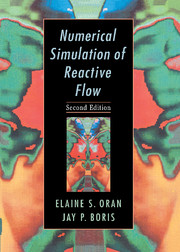Book contents
- Frontmatter
- Contents
- Prologue
- 1 An Overview of Numerical Simulation
- 2 The Reactive-Flow Modeling Problem
- 3 Models and Simulation
- 4 Some General Numerical Considerations
- 5 Ordinary Differential Equations: Reaction Mechanisms and Other Local Phenomena
- 6 Representations, Resolution, and Grids
- 7 Diffusive Transport Processes
- 8 Computational Fluid Dynamics: Continuity Equations
- 9 Computational Fluid Dynamics: Using More Flow Physics
- 10 Boundaries, Interfaces, and Implicit Algorithms
- 11 Coupling Models of Reactive-Flow Processes
- 12 Turbulent Reactive Flows
- 13 Radiation Transport and Reactive Flows
- Index
13 - Radiation Transport and Reactive Flows
Published online by Cambridge University Press: 09 October 2009
- Frontmatter
- Contents
- Prologue
- 1 An Overview of Numerical Simulation
- 2 The Reactive-Flow Modeling Problem
- 3 Models and Simulation
- 4 Some General Numerical Considerations
- 5 Ordinary Differential Equations: Reaction Mechanisms and Other Local Phenomena
- 6 Representations, Resolution, and Grids
- 7 Diffusive Transport Processes
- 8 Computational Fluid Dynamics: Continuity Equations
- 9 Computational Fluid Dynamics: Using More Flow Physics
- 10 Boundaries, Interfaces, and Implicit Algorithms
- 11 Coupling Models of Reactive-Flow Processes
- 12 Turbulent Reactive Flows
- 13 Radiation Transport and Reactive Flows
- Index
Summary
The electronic, atomic, and molecular motions associated with internal energy cause materials to emit and absorb electromagnetic radiation continuously. Electromagnetic radiation spans a wide spectrum, ranging from radio waves to cosmic rays, and it is an important energy-transport mechanism. As such, it is an important physical effect and material diagnostic in reactive-flow systems, such as black-hole accretion disks, stellar interiors, large-scale fires, small-scale laboratory flames, rocket propulsion, hypersonic shock layers, and laser-matter interactions. For example, in forest fires or furnaces, radiation can cause ignition at widely separated regions by a phenomenon called flashover. Flashover occurs when the radiation from one combustion region heats a distant surface until it ignites. Radiation can also be important in engine combustion chambers, where temperatures reach two or three thousand degrees Kelvin. Soot particles formed by combustion processes emit and absorb radiation, thereby changing the heat balance and thus the buoyancy of the products.
The energy-exchange mechanisms for conduction and convection differ fundamentally from those of radiation. For example, emitted radiation depends very sensitively on the material temperature and becomes more important as the temperature increases. The net radiant energy transferred generally depends on differences of the absolute temperatures raised to the fourth power, following the Stefan-Boltzmann law. The energy-exchange mechanisms for convection and conduction usually depend linearly on the temperature difference. Another important difference between radiation transport and transport by conduction or convection is that radiant energy, carried by photons, can be transported in a vacuum as well as in a material medium. In convection and conduction, energy is transported by the material medium.
Radiation transport is a major scientific field in its own right.
- Type
- Chapter
- Information
- Numerical Simulation of Reactive Flow , pp. 488 - 520Publisher: Cambridge University PressPrint publication year: 2000



